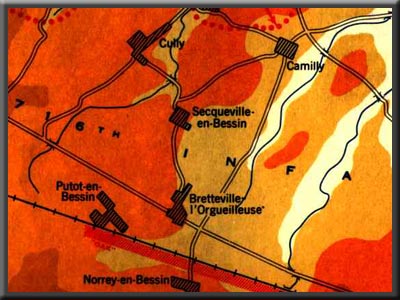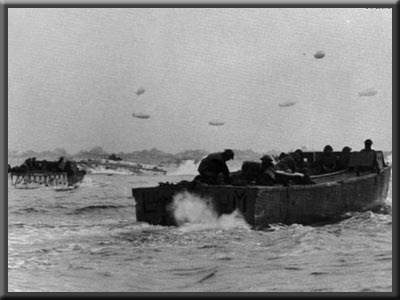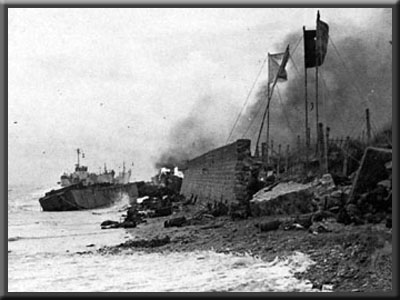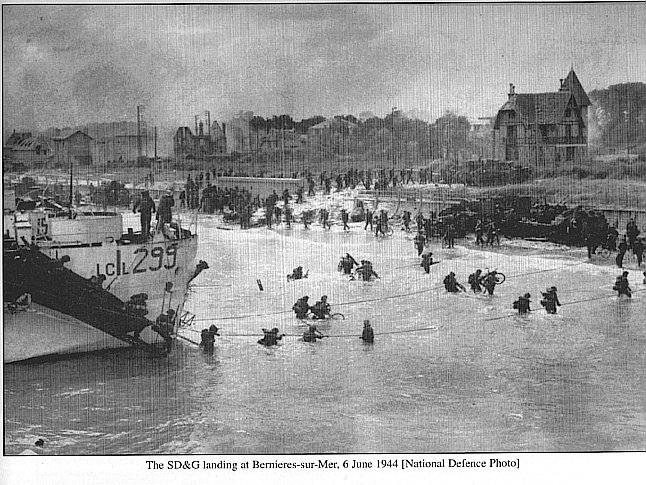
Canada and WW2 - Juno Beach
| Juno Beach
|
| “We thought we were on the beach. Really we were hooked on an underwater obstacle. The doors went down and I very gallantly shouted 'Follow me!' and disappeared into eight feet of water. The fire was heavy and almost every man on my right was wounded or killed. I'd have been hit too but we found later that the machine gun that was doing the damage couldn't traverse that far. The man next to me was hit four or five times. I wasn't touched.” The Canadians at War 1939/45, vol. 2 (Montreal: Reader's Digest Association (Canada) Ltd., 1969), p. 442. |
| Considered CanadaÂ’s greatest military contribution, landing in between two British assault waves (Gold and Sword) along with 2 American waves (Utah and Omaha) on D-Day demonstrated how important the Canadians were to the Allied assault forces, and established the Canadians to the rest of the world as a military force at the time. The Canadians would not disappoint either, as they were the only force to basically complete all of their objectives for the day. |
| The Canadian 3rd Division had been selected to take part in the invasion in July 1943 and trained in assault landings in Scotland and in inter service cooperation, particularly with the Royal Navy, in the Portsmouth area. Throughout training the 3rd Division worked closely with the 2nd Armoured Brigade which was equipped with DD tanks. On 26 May the Division was sealed into its concentration area and on 1 June 15,000 Canadians and 9,000 British, who together made up the Division, began to board at Southampton. Four days later they set sail for France. |
| The Plan |
| JUNO Beach was divided into two sectors which, looking inland from the sea to the land, were right to left MIKE and NAN. The assault was on a 1Aa two-brigade front with the 7th Brigade Group landing at Courseulles on M IKE sector and 8th Brigade Group landing at Berniere on NAN sector. Each brigade had DD floating tank support from the 6th Armoured and 10th Armoured Regiments respectively, plus fire support from the 1 07mm mortars of the Cameron Highlanders of Ottawa. 8th Brigade was to be closely followed by elements of the 4th Special Service Brigade charged with mopping up, making contact with 3rd British Division Commandos and taking the German radar station at Douvres la Délivrande. The 9th Brigade, the follow-up brigade, was scheduled to land in either the 7th or the 8th Brigade areas according to the progress made. |
|
The Canadians' objectives were the capture and clearance of the coastal villages and towns along JUNO Beach, particularly Courseulles, St. Aubin and Berniere, and of specific villages inland. The Division had three objective lines, 'Yew', 'Elm' and 'Oak', which corresponded to three phases in their D-Day plan. The third phase was intended to be on 'Oak' which ran along the railway line just south of the N13 road from Caen to Bayeux. There the 3rd Division was to reorganise in preparation for further advance and to repel enemy counterattacks'.
|
| What Happened on D-Day |
| During the night of 5 June, and early morning of 6 June, RAF Bomber Command hammered likely German defence positions along the Normandy coastline. At dawn the US Army Air Force took over and continued the attack until, as even, where along the invasion front, the Royal Navy joined in. Off JUNO Beach were eleven destroyers and support craft adding their weight to the bombardment including two Canadian destroyers, the Algonquin and the Sioux. |
| The crossing for the troops at sea was rough and the time for the assault was put back by ten minutes because the heavy seas had delayed some of the landing craft, but despite considerable opposition from entrenched German positions relatively unaffected by the air and sea bombardments, the Canadians got ashore. |
|
The Canadian soldiers scheduled to land at Juno Beach warily approached the coastline in their landing craft. Wet, cold, and seasick, they were also confident. On "Mike" sector, most of the 1st Hussars' tanks managed to get ashore in good order to provide covering fire as the Regina Rifles touched down just after 8:00 a.m. That was fortunate since the preliminary bombardment had failed to knock out many German defensive positions. The near invulnerable pill-boxes could be destroyed only by direct hits through their observation slits but, working in tandem, the tanks and infantry succeeded in fighting their way off the beach and into the nearby town of Courseullessur Mer where they became engaged in house-to-house combat. They were moving inland by late afternoon. Other Reginas never reached the beaches a reserve company suffered terrible losses when its landing craft struck mines hidden by high tide.
|
| The company of Victoria's Canadian Scottish and most of The Royal Winnipeg Rifles at "Mike" made it ashore without much trouble, the beneficiaries of accurate naval gunfire which neutralized the German battery that dominated their area of the beach. The Winnipeg company at the western edge of Courseulles was not so lucky. There the bombardment had missed its targets, and the landing craft came under brisk gunfire while they were still far offshore. Although forced to "storm their positions `cold' [they] did so without hesitation", the unit's war diary noted. Many men died the instant they waded into the chest-high water. Nonetheless, the survivors advanced past the beach defences, cleared the minefields, and occupied the adjoining coastal villages. The victory did not come cheaply. In a few hours, the company lost almost three-quarters of its men. |
| But none of the "Little Black Devils", as the regiment was nicknamed, "had flinched from his task, no matter how tough it was [or] failed to display courage and energy and a degree of gallantry." They had not been alone. The Winnipegs' commanding officer later paid tribute to The 1st Hussars' "gallantry, skill and cool daring" in coming to the assistance of his battalion "time and again throughout D-Day, without thought of their own safety or state of fatigue. ..." |
|
At "Nan" sector on Juno Beach, The North Shore Regiment and The Queen's Own Rifles also encountered enemy gun emplacements that had survived the preliminary bombardment. One concrete bunker and its defenders inflicted heavy casualties on the North Shores and destroyed several Sherman tanks of The Fort Garry Horse before being silenced. The North Shore's other companies made it ashore without incident, but needed six hours and armoured support to take the town of Tailleville.
|
| Toronto's Queen's Own Rifles received the worst battering of any Canadian unit on D-Day. The initial bombardment on their sector of "Nan" had barely dented the enemy's fortifications. The DD tanks, supposed to "swim" in ahead of the infantry to diminish German resistance, had been forced by high waves to land after them--"within a few hundred yards of the muzzles of the beach defence guns", one tank commander recalled afterward. Only a few made it into action. |
| A half-hour late, the landing craft carrying the Queen's Own hit the beach more or less intact. Then the bloodbath began, the men making a mad dash from the shoreline to a seawall 183 metres away with no cover in between. A hidden German 88 opened up on the lead platoon of one company, decimating two-thirds of it before being silenced. Only a handful survived to get off the beach. |
|
A second Queen's Own company landed directly in front of an untouched enemy strongpoint and very quickly lost half of its men, until three riflemen eliminated it with hand grenades and small arms fire. The price had been high, but the Queen's Own moved off the beach. The war diary of this, one of the oldest regiments in the Canadian Army, reflected the unit's unflagging spirit under onerous conditions.
|
| The reserve units of the Canadian Scottish and the Chaudières arrived on the heels of the initial assault. The Scottish suffered the lightest casualties of any Canadian battalion on D-Day. But, coming in on the rising tide, many of Le Régiment de la Chaudière's landing craft struck concealed mines, and their occupants had no option but to throw off their equipment and swim to shore. Soon, both regiments were surging forward. By noon, the 9th Infantry Brigade was on its way to the beaches to exploit the 3rd Canadian Infantry Division's hard-won gains. |
| Although only one Canadian unit reached its D-Day objective, the first line of German defences had been completely smashed. By evening, Canadian troops had progressed further inland than any of their Allies. It was a remarkable achievement but, despite casualties being less than expected, it was an expensive one, too. "The German dead were littered over the dunes, by the gun positions", a Canadian journalist reported. "By them, lay Canadians in bloodstained battledress, in the sand and in the grass, on the wire and by the concrete forts. ...They had lived a few minutes of the victory they had made. That was all." To ensure that D-Day would succeed, 340 Canadians had given their lives. Another 574 had been wounded and 47 taken prisoner. |
| And a resounding success it was. The British and Americans had also come ashore and pushed inland; the Allied beachheads soon formed a continuous front. By the end of D-Day, the Allies had landed as many as 155,000 troops in France by sea and air, several thousand vehicles, hundreds of guns and about 4,000 tons of supplies and, astonishingly, had achieved complete surprise in doing it. The Atlantic Wall had been breached. But the battle had just begun. The bridgehead had to be secured and expanded to prevent the Wehrmacht from driving the Allies back into the sea. |
Published on: 2004-08-05 (35646 reads)
Recent Reviews
- War Horse 2012-01-02
- Legion 2010-01-23
- Zombieland 2009-10-02
- The Martyr's Oath: The Apprenticeship of a Homegrown Terrorist 2009-08-20
- Bachman Cummings 2009-06-22
- Star Trek 2009-05-03
- X-Me Origins: Wolverine 2009-05-01
- Soloist 2009-04-24







